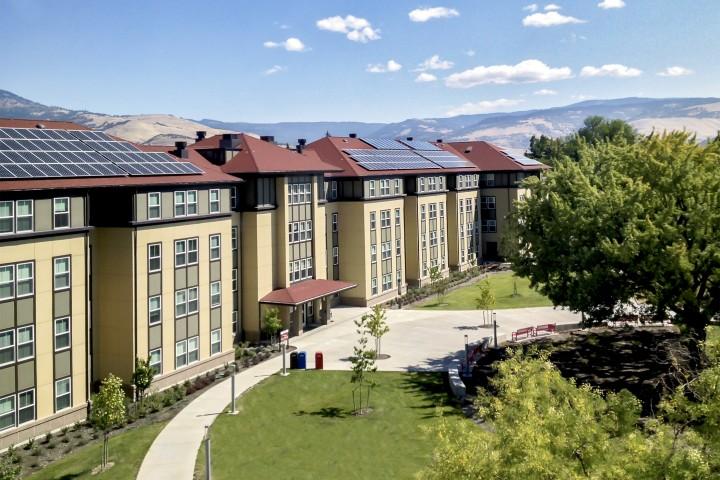Five Questions with…a Southern Oregon University Student on Carbon Reduction
We talked to a Southern Oregon University student to learn how the university is making energy efficiency gains.
Chevrolet supports the cause for cleaner air. We’re reimagining manufacturing to lower environmental impact and designing efficient vehicles. But there are other ways to fuel the clean-energy movement beyond transportation and industry. To us, it’s about finding the innovators who are doing big things to leave a smaller footprint.
From New York to Florida to Oregon, colleges are aggressively improving their energy efficiency and engaging the next generation along the way. After collaborating with some strong partners, we developed a way to monetize their progress, providing them with ammo to reinvest in even more clean energy technologies.
U.S. colleges can now use the voluntary carbon market to turn their energy efficiency gains into carbon credits that they can sell to companies. Southern Oregon University is the latest to benefit from the program; we will purchase their carbon credits from energy efficiency gains in two of their LEED-certified residence halls.
Our goal is to get more people thinking about carbon and finding new ways to reduce it in their own backyard. Carbon may not be a conversation topic at your dining room table tonight, but we think it should be.
Here we talk with Shaun Franks, a recent SOU graduate fluent in carbon reduction about his involvement in the campus’ clean-energy efforts and why implementing these environmentally responsible practices is so important.
GM: What kind of energy efficiency gains has SOU made to date?
Shaun: Southern Oregon University has really proven itself as a leader in renewable energy and energy efficiency measures. SOU was the first university in Oregon, and one of the first in the nation, to offset 100 percent of its energy use with clean, renewable power, and it is the first university in the nation to balance 100 percent of its water consumption. During the last four years, SOU has gained 185 kW of solar photovoltaics, renovated existing building space to be more energy efficient, and opened the new LEED Gold-Certified Raider Village housing and dining complex. I’m glad SOU allowed students to be a major part of many of those initiatives. I don’t think we would have achieved LEED- Gold or many of our other energy efficiency initiatives if SOU didn’t listen to the voices of its students.
Student groups and the President’s Sustainability Council worked to ensure we first signed the President’s Climate Commitment formalizing our campus’ climate neutral goal, measured our greenhouse gases and created a Climate Action Plan to keep us on track! “What gets measured, gets managed,” is our belief.
How did SOU begin to work with Chevy on the carbon-reduction initiative?
Last year, SOU students went to the Association for the Advancement of Sustainability in Higher Education conference in Nashville, Tennessee. While there, I heard David Tulauskas, the director of sustainability at General Motors, speak about Chevrolet’s Carbon Reduction Initiative. SOU has sustainability deeply rooted in our culture on campus so when I heard about this opportunity I knew SOU would be supportive of the idea.
I connected Roxane Biegel-Coryell, SOU’s sustainability coordinator, with David during the conference. That’s the collaboration; SOU listens to its students, involves them in leadership roles on campus, and encourages us to reach out to our communities.
You’ve been involved quite a bit in these efforts. Do a lot of other students care about the campus’ environmental initiatives? How do other students engage?
I think academia creates an atmosphere of innovation and problem solving, especially for campus environmental initiatives. From what I’ve seen, students have a strong desire to create solutions for energy, food, water, waste, and transportation, along with many other environmental initiatives. At SOU, students created the SOU Green Fund to invest student dollars in local initiatives related to energy, water, and campus sustainability. We felt students are always full of innovative ideas and intellectual capital that fit the niche of their individual universities and communities, but often lack financial resources to manifest those ideas.
This fall, student leaders will run an energy conservation campaign in the new halls to educate and engage student residents in the university’s conservation efforts. I think students realize they can actually have an impact in making their campus and communities more sustainable. Student engagement at SOU has always been amplified by the support of university staff, administration, and community partners.
What role should business play in helping alleviate some of the world’s biggest environmental challenges?
I think businesses are beginning to play a leading role in solving environmental challenges by rethinking the way they do business and investing in innovative ways to make a lasting impact. Businesses are starting to take a serious look at the triple bottom line — people, profit, and planet.
There is a real synergy between universities and businesses working on environmental solutions together. The resources controlled by these institutions and their impacts are vast. Imagine if only a small portion of their collective efforts were focused on alleviating environmental challenges. Student leaders across the country are taking the initiative to make our campuses and the world a better place, and I know they appreciate it when corporations stand ready to support them when they lead.
How does your school, its students and the surrounding community benefit from the university’s clean energy progress?
There is a precedent being set by SOU’s clean energy progress. We are setting a good example of how businesses and universities can work together to achieve common goals. Our school has received national recognition from the Department of Energy and the Environmental Protection Agency for our efforts on clean energy. I believe SOU will benefit from the recruitment and retention of students concerned with environmental impacts.
For students there is a lot of awareness and engagement happening on campus. They are beginning to think a lot about their energy use. I’ve seen students engage in multiple ways from managing the investments of SOU Green Fund, researching clean energy at the SOU Center for Sustainability, having their voices heard on campus issues at the President’s Sustainability Council.
Our community is witnessing a lot of work being done at SOU, which continually creates opportunities for green jobs. Through this, SOU is making an investment in our communities.




